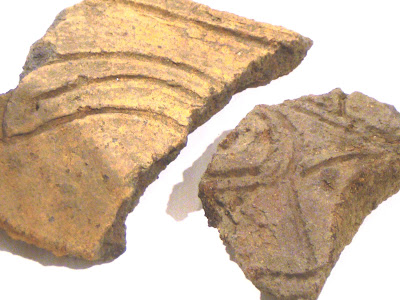Collected
Meanings:
Japanese Pottery and Travel
Stories
Dick Lehman
Goshen College Visual Arts
Gallery
Goshen, Indiana
12 July, 2010
My first reaction
to this exhibit was one of curious pleasure mixed with acute apprehension. Asian ceramics always tweak my interest. My aunt Ruby FitzGerald (FitzRu) studied pottery
under a Japanese Master (one of the first Western women to do so), and I have
always freely lost myself in the Asian ceramics collections of the Art
Institute Chicago and the Minneapolis Art Institute. On the other hand -- of what real use is an
Asian ceramics collection?
I need not have
worried. Dick Lehman is both an expert
in the field of ceramics and an accomplished collector. Collected Meanings explores decades of
collecting and travel experiences in Japan as both a record of an on-going
cultural exchange between the United States and Japan, and as an educational
introduction to the variety of methods, textures, finishes, and shapes
historically common to Japanese ceramics.
One might begin
Lehman’s tour in one of two ways. One
might rush right into the cases of ceramics and begin exploring, or one might
choose to engage the well placed magazine articles and travel memoirs posted
along the wall.
I choose the
former. Chronologically, the oldest
pieces in the collection are pottery shards from prehistoric Japan. The most chilling are irradiated ceramic roof
tiles from Hiroshima.
As a contrast,
Lehman includes a highly polished, very refined incense burner -- the detail is
meticulous and time consuming. Across
the aisle two large serving dishes -- so common that it was deemed acceptable
to leave the marks from having stacked them in the kiln embedded in their
finish like inexpensive flower pot casters.
Certain exhibits
are noted for their techniques. Dick
Lehman has been experimenting with long firing techniques and with processes of
embodying or the “rapid fossilization” of organic matter into clay
designs. It is interesting to match his
articles with the pieces ( Dick Lehman Gallery and Homepage
). The tray below shows samples of the “fossilization”
or carbonization of seashells. This bowl
shows a traditional Japanese leaf imprint finish.
Equally interesting
was the chance to see various methods us imprinting using the same materials in
different ways. This bowl indicates a “random”
rope imprinting design. Contrast it with
the precision of the rim on this platter.
Other samples show
dyed designs such as this traditional horse-eye platter or the tokkuri (sake pitcher).
After a point, I
strongly recommend that one just stands back to admire the organic shapes
presented in the cases.
In all this is a
great afternoon break. Lehman has done a
great job integrating his website with the show. While his collection is not catalogued on the
web-site, his cumulative writing for Ceramics Monthly are posted on the
site. I would recommend browsing through
them before heading over to the campus.
 |
| Clay roofing tile rebaked during the WWII American atomic bombing of the city. |
 |
| Bowl showing rope imprint design |
 |
| Note the horse-eye pattern on this Traditional platter. |
 |
| Note the imprints left by spacing casters on these "cheap" trays. |
 |
| Platter showing rapid fossilization or carbonization technique |









Thanks for the post, wonderful japanese design.
ReplyDeleteHere, a gallery in Paris, which has nice japanese art pieces:
Yakimono Japanese Ceramics